Bulletin – September 2013 Global Economy The Performance of Resource-exporting Economies
- Download the article 608KB
Abstract
The surge in demand for resources over the past decade led to sharp increases in the terms of trade not just for Australia, but also for other economies with comparable resource exports such as Brazil, Canada, Chile, Russia and South Africa. Each of these economies experienced an increase in investment, although the surge in resources investment in Australia has been particularly large. The real exchange rates in these economies appreciated, weighing on other trade-exposed industries, while parts of the non-traded sector benefited from the boost to income and activity from the resources boom. In general, the resource-exporting economies experienced relatively strong growth in economic activity and inflation remained well contained, particularly compared with previous booms in resource prices.
Introduction
As a major exporter of resource commodities, Australia has been a beneficiary of the significant pick-up in the pace of urbanisation and industrialisation in emerging Asian economies over the past decade. The sharp increase in demand for commodities, coupled with their relatively inelastic supply, saw global commodity prices increase substantially, boosting the terms of trade (Graph 1). The value of Australia's resource exports increased more than fivefold over the 10 years to 2012 and now accounts for over 10 per cent of nominal GDP. The terms of trade boom has led to a surge in resources investment and a significant appreciation of the exchange rate, forces which have been driving structural changes in the Australian economy. This article compares Australia with five other economies with broadly comparable resource exports: Brazil, Canada, Chile, Russia and South Africa.
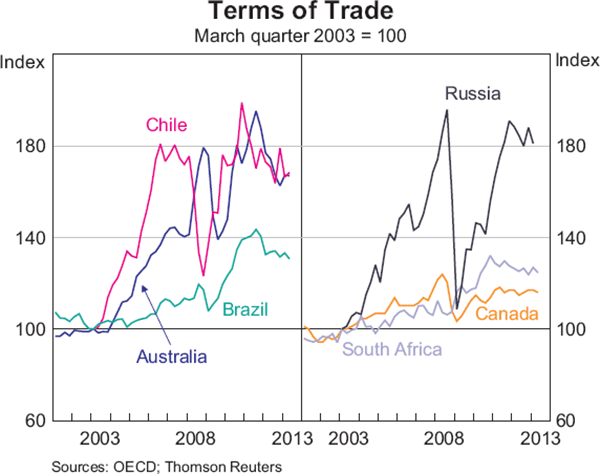
Along with Australia, these economies account for almost two-thirds of the world's proven reserves of iron ore, around half of copper and gold reserves and a third of coal reserves (Table 1). These resource economies represent an even larger share of global iron ore and coal export markets, reflecting the fact that their resource production significantly exceeds domestic consumption requirements. However, apart from Russia and Canada, the resource-exporting economies represent a small share of global oil and gas reserves, which are dominated by economies in the Middle East; only Australia and Russia are significant exporters of liquefied natural gas (LNG).
| Australia | Brazil | Canada | Chile | Russia | South Africa | |
|---|---|---|---|---|---|---|
| Iron ore | ||||||
| – Reserves | 21 | 20 | 3 | 0 | 18 | 1 |
| – Exports | 46 | 25 | 3 | 1 | 2 | 6 |
| Coal | ||||||
| – Reserves | 9 | 1 | 1 | 0 | 18 | 4 |
| – Exports | 30 | 0 | 5 | 0 | 10 | 5 |
| Copper | ||||||
| – Reserves | 13 | 0 | 1 | 28 | 4 | 0 |
| – Exports | 5 | 0 | 3 | 23 | 3 | 0 |
| Gold | ||||||
| – Reserves | 14 | 5 | 2 | 8 | 10 | 12 |
| – Exports | 6 | 1 | 6 | 1 | na | 3 |
| Natural gas | ||||||
| – Reserves | 2 | 0 | 1 | 0 | 18 | 0 |
| – Pipeline exports | 0 | 0 | 12 | 0 | 26 | 0 |
| – LNG exports | 9 | 0 | 0 | 0 | 5 | 0 |
| Oil | ||||||
| – Reserves | 0 | 1 | 10 | na | 5 | 0 |
| – Exports | 1 | 1 | 3 | 0 | 10 | 0 |
|
Sources: BP (2013); Bureau of Resources and Energy Economics; United Nations Comtrade database; UNCTADstat; U.S. Geological Survey |
||||||
These economies vary in terms of the contribution of resources to production, their level of development and their macroeconomic frameworks. For Chile and Russia, resource exports account for around one-fifth of economic output, compared to around one-tenth for Australia, Canada and South Africa, while Brazil's resource exports are relatively small compared with its economy (Graph 2). The economic importance of resource exports has tended to increase over the past 10 years, except in Russia, where the broader economy expanded rapidly from a low base following the financial crisis it experienced in 1998. Australia, Canada, Chile and Russia are classified by the World Bank as high-income economies, while South Africa and Brazil are classified as upper-middle-income economies. There are some similarities in the macroeconomic frameworks, with all the economies – apart from Russia – having floating exchange rates and inflation-targeting central banks.
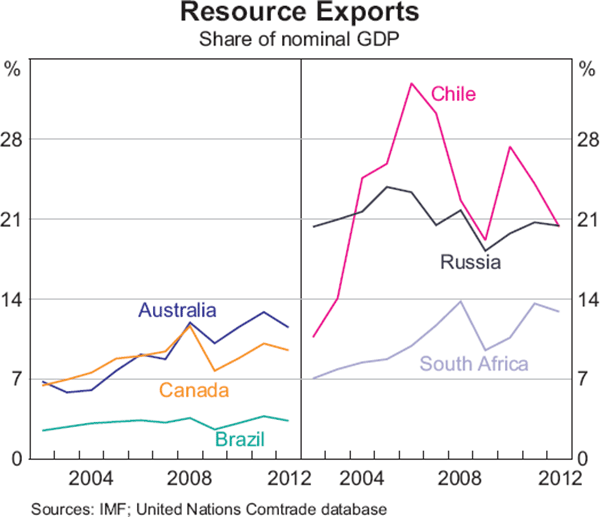
The Surge in Demand for Resources
China's rapid economic growth over the 2000s underpinned a significant increase in global demand for resources; investment in Chinese infrastructure, building construction and heavy industry has been particularly steel intensive, boosting demand for iron ore and coking coal (Roberts and Rush 2010; Coates and Luu 2012). At the same time, rising household incomes have translated into higher demand for electricity and consumer goods. Despite China being a major producer of resources, domestic production has been unable to keep up with the growth in consumption, so China has increasingly turned to global markets to meet its demand.
Within a relatively short time, China's imports have risen significantly as a share of global trade in the key commodities produced by the six resource-exporting economies (Graph 3). This rise in demand from China drove substantial price increases for a wide range of resources (Table 2). Despite the sharp slowdown in the pace of growth in the advanced economies over the past five years, Chinese demand for commodities continued to increase during this period, only dipping briefly in 2009. Nevertheless, the pace of growth in Chinese resource imports has slowed over the past three years while global supply has expanded. These factors have contributed to commodity prices declining from their peaks, although they remain well above the levels that prevailed in the early 2000s.
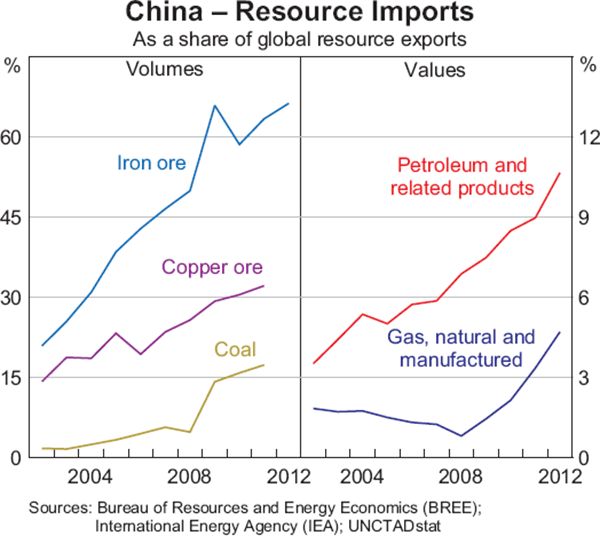
| Month of peak price |
From Jan 2002 to peak |
From peak to Aug 2013 |
From Jan 2002 to Aug 2013 |
|
|---|---|---|---|---|
| Iron ore | May 2011 | 667 | −24 | 482 |
| Coking coal | Nov 2008 | 469 | −53 | 165 |
| Thermal coal | Jan 2012 | 213 | −29 | 123 |
| Copper | Feb 2011 | 427 | −25 | 294 |
| Gold | Sep 2012 | 406 | −22 | 297 |
| Oil | Jul 2008 | 444 | −13 | 376 |
|
(a) Resource prices are in SDR terms; iron ore, coking coal and thermal coal prices are average Australian export prices Sources: Bloomberg; RBA |
||||
The surge in Chinese demand for resources clearly shifted the direction of trade for the six economies (Graph 4). The share of Australian, Chilean and Brazilian resource exports bound for China increased from around 10 per cent in 2002 to around 30 per cent in 2012. While the proportion of Russian, South African and Canadian resource exports destined for China also increased, this change was not as significant, as they were less directly exposed to shifts in Chinese demand. In aggregate, these six economies met more than one-quarter of China's resource import demand in 2012, up from around 18 per cent in 2002. Of the six economies, Australia meets the largest share of China's resource import demand, reflecting Australia's dominance in both the iron ore and coal export markets and also its geographical proximity to China. The recent decline in the share of Chinese imports sourced from the six resource-exporting economies reflects declines in the prices of bulk commodities and relatively strong growth in the value of imports of petroleum and related products, predominantly sourced from the Middle East and Africa.
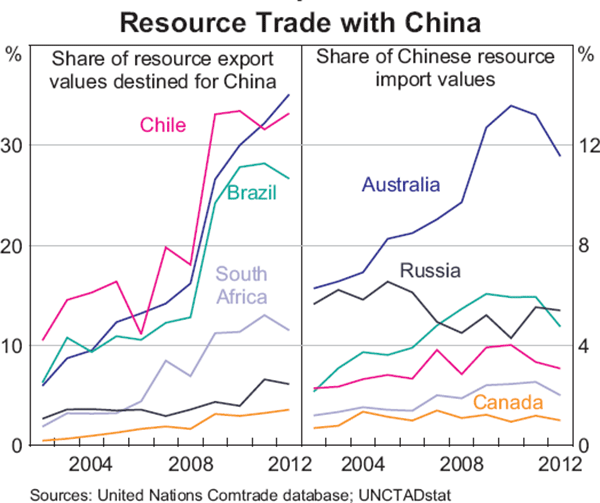
Resources Investment and Exports
The surge in demand for resources led to significant investment in the resources sector in all six economies over the past decade. Nevertheless, the magnitude of the pickup varied considerably, depending on each economy's resource endowment, the availability of relevant extraction technology and the economy's investment environment. Overall, a range of indicators suggest that Australia's resources investment boom was particularly large, especially in LNG and iron ore.
Chinese demand for iron ore increased substantially, supporting resource investment projects in the economies with large iron ore reserves. The share of iron ore projects in global minerals projects rose from under 5 per cent in 2002 to around one-third in 2012, driving minerals investment in Australia and Brazil (Graph 5; Ericsson 2003; Ericsson and Larsson 2013). Similarly, investment in Chile was supported by Chinese demand for copper. Canada experienced a boom in minerals investment projects, although the composition was relatively broad based, including gold, base metals and iron ore projects (Canada also experienced a boom in energy projects, particularly in unconventional oil extraction).
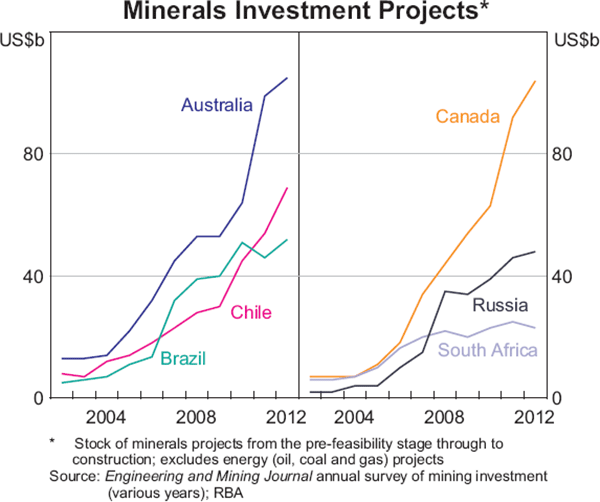
Improvements in resource extraction technology have also influenced the timing and location of resources investment, particularly for oil and gas projects (Alquist and Guénette 2013). In Canada, investment in unconventional oil extraction, primarily from the Alberta oil sands, more than doubled as a share of the Canadian economy over the past 10 years. In the United States, the shale gas boom over recent years has shifted the economy from being an importer of natural gas, to potentially becoming a significant exporter of LNG in the future. The LNG investment boom in Australia has also been partly driven by technological improvements in the extraction of both onshore coal seam gas and offshore gas, with the development of floating LNG technology.[1]
Given the highly capital-intensive and long-term nature of resource projects, the local investment climate is an important consideration for global resources companies when they make investment decisions. To measure this, the Fraser Institute surveys executives from mineral and petroleum companies on a range of factors influencing investment decisions, including political stability, the cost of compliance, the tax burden, the quality of infrastructure and the availability of skilled labour. According to these surveys, Australia, Canada and Chile have relatively low barriers to investment, underpinning the resources investment booms that have taken place in those economies over the past decade (Wilson, McMahon and Cervantes 2013; Angevine, Cervantes and Oviedo 2012).
These factors affecting the location of resources investment also help to explain developments in LNG capacity over the past decade (Jacobs 2011). The first wave of expansion was in Qatar, another economy considered to have a favourable investment climate, with LNG production capacity more than doubling over the second half of the 2000s (Graph 6). A second wave of expansion is underway in Australia, and the International Energy Agency (IEA) forecasts that Australian LNG exports will increase rapidly from 2015, making Australia the world's largest exporter of LNG. Looking ahead, LNG projects currently in the planning stage are mostly in the United States, and the IEA is forecasting US LNG exports to increase substantially later this decade. The IEA has noted that many of the other projects in the planning stage could be restrained by political instability and regulatory uncertainty, particularly those located in parts of Asia, the Middle East and Africa (IEA 2013).
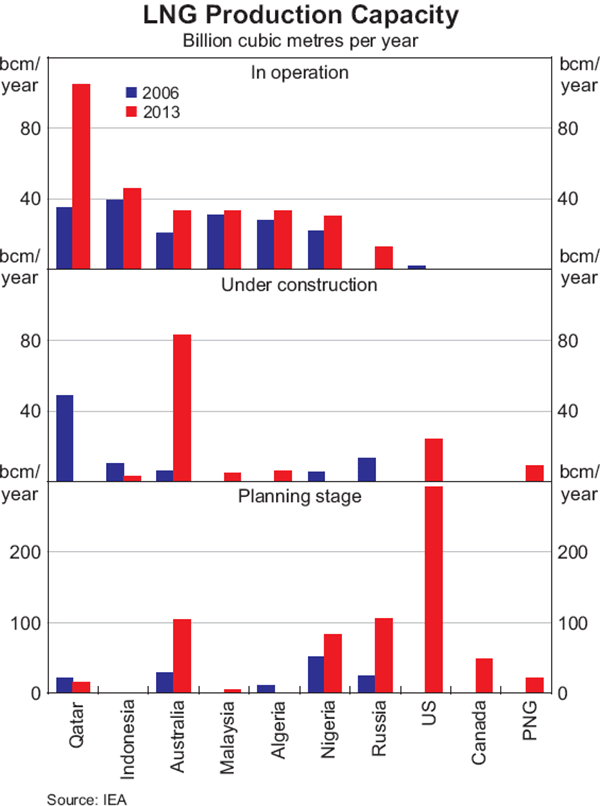
For the bulk commodities, trends in supply have also differed considerably across countries over the past decade. Australian iron ore exports increased more rapidly than for Brazil, Canada or South Africa, owing to the efficient coordination of supply expansions across mine, rail and port facilities, with Australia's share of global exports rising to around 45 per cent over the period (Graph 7). In contrast, while Australian exports continued to represent over half of the global trade in coking coal and a little under 20 per cent of thermal coal, the rate of growth of coal exports was much slower than for iron ore, reflecting challenges in coordinating expansion along the chain of infrastructure (that is, mines, rail and port facilities; Connolly and Orsmond 2011). In comparison, the most rapid capacity expansions occurred in Indonesia, where thermal coal producers were able to use river barges to transport coal, avoiding the need to invest in rail networks (Graph 8; IEA 2011). Exports of coal from the United States have also grown rapidly since 2009, owing to reduced domestic demand for coal following the global financial crisis and the boom in shale gas production. Forecasts from the Bureau of Resources and Energy Economics (BREE) suggest that Australia's share in these bulk commodity export markets will increase over coming years, as the relatively large investments in Australia flow through to increased production, while growing domestic demand is expected to gradually reabsorb production capacity in the United States.
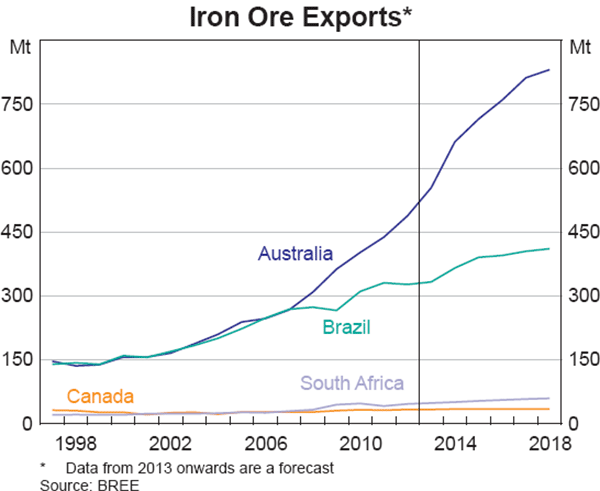
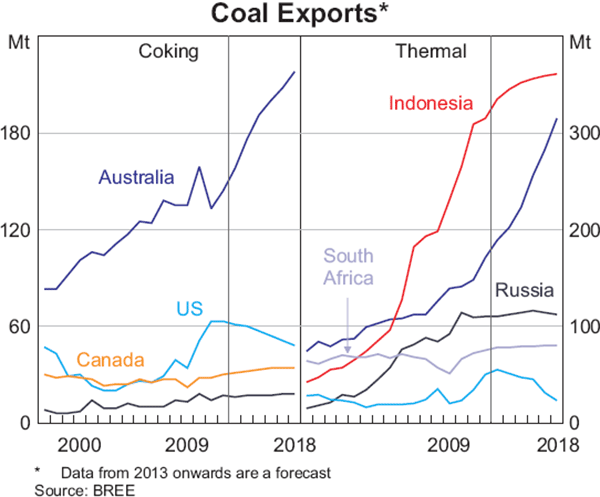
The Broader Economic Implications
Over the past decade, the resource-exporting economies experienced the largest resources boom since at least the 1970s, and in the case of Australia, the largest in its history. Such booms are inevitably challenging for an economy as it adjusts to the dramatic shift in relative prices. To analyse this process, it is useful to consider the economy as being composed of three sectors: the resources sector, the other trade-exposed sector and the non-traded sector.[2]
Real exchange rate adjustment
One of the main ways that resource-exporting economies adjust to a surge in demand for resources is through appreciation of the real exchange rate. The real exchange rate measures the relative price of goods and services across countries, and the international competitiveness of the trade-exposed sector. The appreciation of the real exchange rate over the past 10 years has assisted all the resource-exporting economies with the reallocation of the factors of production towards the resources sector and away from the other trade-exposed sector (Graph 9). Real exchange rate adjustment can occur through an appreciation of the nominal exchange rate or through higher inflation of prices and wages as experienced in many countries in the 1970s. In Australia, Canada and Chile, the real appreciation over the past 10 years occurred predominately through the adjustment of the nominal exchange rate, with inflation remaining relatively well contained (Table 3, Graph 10). In contrast, in Russia – which has a managed exchange rate – and South Africa, the adjustment occurred through high inflation, while Brazil experienced a mix of nominal exchange rate appreciation and elevated inflation.[3]
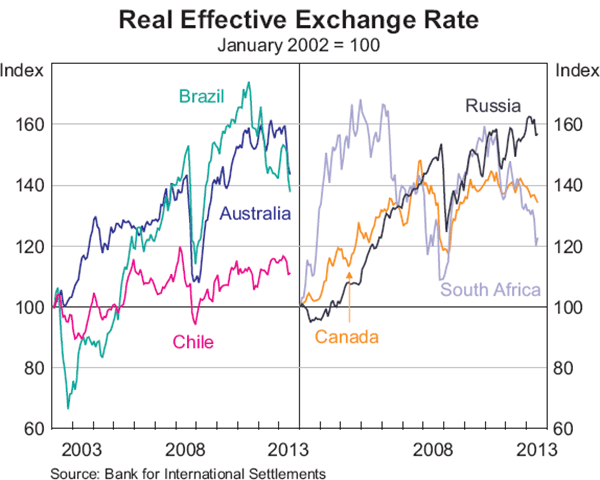
| Australia | Brazil | Canada | Chile | Russia | South Africa | |
|---|---|---|---|---|---|---|
| Nominal exchange rate | 38 | 5 | 40 | 18 | −31 | −9 |
| Relative prices(a) | 5 | 38 | −5 | −3 | 132 | 39 |
| Real exchange rate | 46 | 45 | 33 | 14 | 60 | 27 |
| – Peak month | Aug 2012 | Jul 2011 | Nov 2007 | Mar 2008 | Feb 2013 | Dec 2004 |
| – January 2002 to peak | 64 | 82 | 47 | 23 | 66 | 73 |
| – Peak to July 2013 | −11 | −21 | −9 | −7 | −3 | −27 |
|
(a) Measured by the ratio of the real and nominal exchange rates Sources: Bank for International Settlements; RBA |
||||||
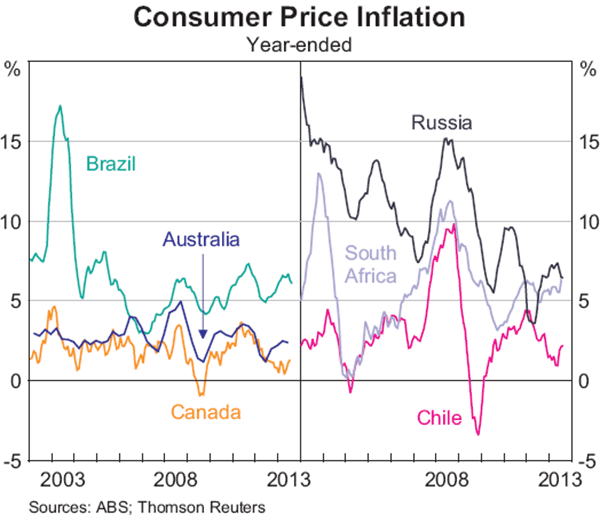
Over the past couple of years, most of the economies, but particularly Brazil and South Africa, have experienced a depreciation of their real exchange rates, consistent with their terms of trade having passed their peaks (Graph 1, Table 3). In Australia and Chile, the real exchange rate remained close to its peak level for some time after the terms of trade had begun to decline, although it depreciated more noticeably in mid 2013.
Investment and employment reallocation
While investment in the resources sector should unambiguously increase in response to higher resource prices, the effect on investment and activity in other sectors is less clear. Although the non-resource sectors benefit from the boost to national income flowing from the higher terms of trade, these sectors have to compete against the resources sector for labour and capital, while the other trade-exposed sector also faces reduced international competitiveness as a result of the higher real exchange rate. In aggregate, all of the resource-exporting economies experienced an increase in the investment share of the economy over the past 10 years, implying that the boom in resources investment more than outweighed any reduction in investment in other sectors (Graph 11). For Australia, Canada and South Africa (where data on mining and non-mining investment are available), mining investment increased strongly over the decade, but the experience of other sectors was mixed, with non-mining investment declining as a share of the economy in Australia (although it still increased in volume terms), while it increased in Canada and South Africa (Graph 12).
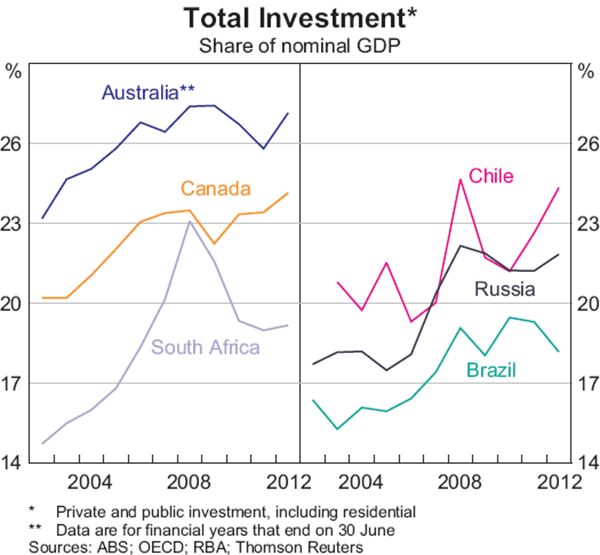
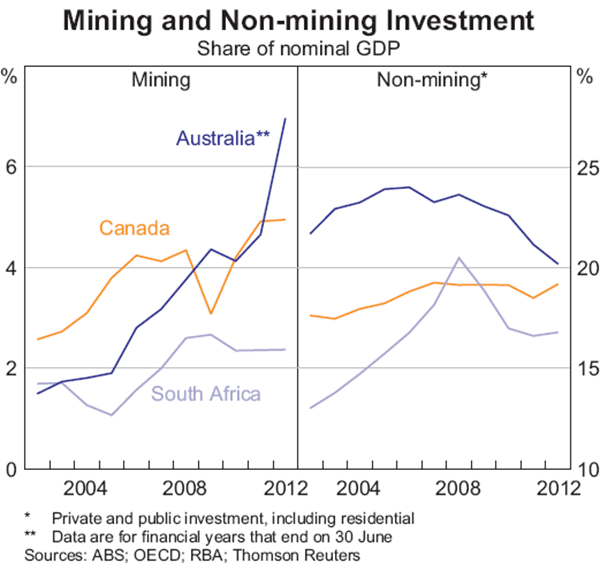
The boom in the resources sector also affects the allocation of employment across sectors, with employment shifting away from the other trade-exposed sector in particular towards resource-related activities. Plumb et al (2013) highlight the fact that in Australia, the composition of employment changed significantly during the course of the terms of trade boom. While the share of labour employed in the other trade-exposed sector declined, the share of total employment accounted for by the resource and resource-related sectors doubled between the mid 2000s and 2012. Francis (2008) makes a similar observation for Canada, but notes that the decline in manufacturing employment in Australia was less pronounced than in Canada, at least between 2002 and 2007. Also, since the mid 2000s, wages in the other trade-exposed sector grew slower than aggregate wages in both economies as the pace of growth in the resources sector accelerated and employment in that sector grew faster than in the broader economy.
While the resources boom led to some shifts in the structure of employment across industries, the resource-exporting economies experienced a substantial increase in aggregate labour demand associated with the boom. Consistent with this, unemployment rates declined over most of the period (although unemployment rose in most economies following the global financial crisis; Graph 13).
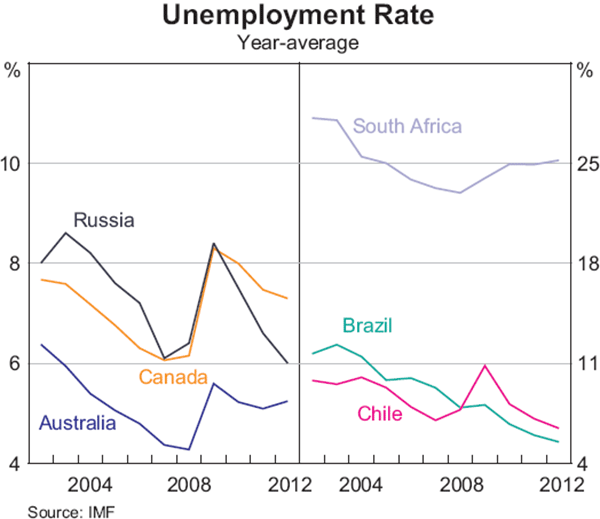
Trends in production
In each of the resource-exporting economies, the other trade-exposed sector steadily declined as a share of output over the period (Graph 14).[4] This is consistent with the factors of production moving away from the other trade-exposed sector towards the resources sector in response to the higher returns that could be earned there, aided by the signal provided by the appreciation of the exchange rate.
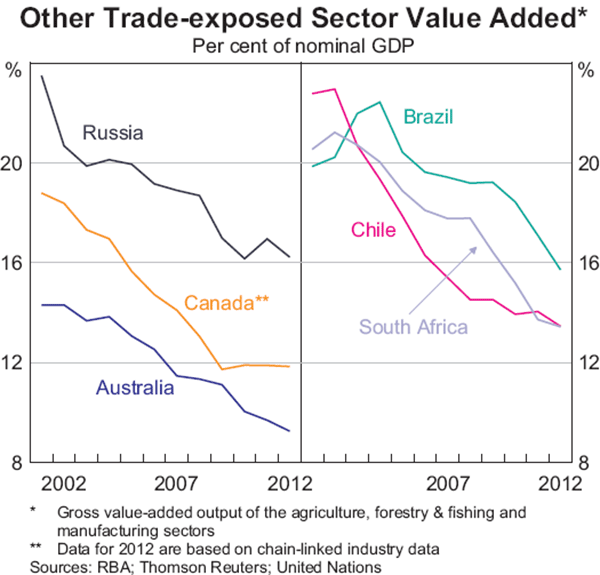
In contrast to the weakness in the other trade-exposed sector, the share of output accounted for by the non-traded sector in these resource-exporting economies was steady or increased over the past 10 years (Graph 15). The income and activity generated by the resources boom stimulated the business services and construction sectors in particular (Francis 2008; Plumb et al 2013).[5]
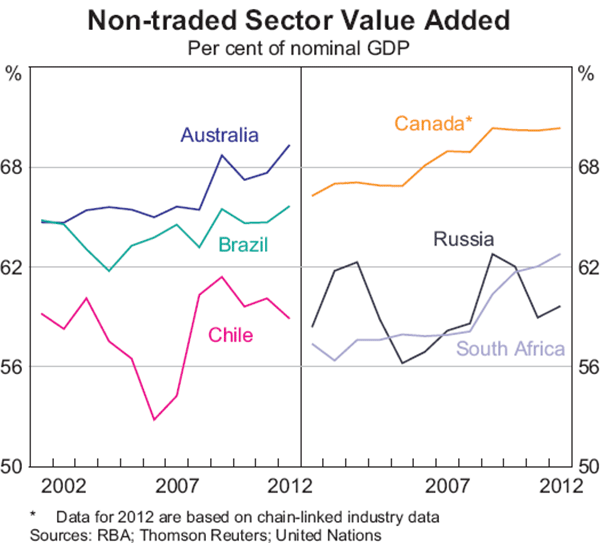
In summary, the resource-exporting economies experienced strong growth in economic activity from 2002 to 2008, with most subsequently experiencing a fall in output in 2009 following the global financial crisis (Graph 16). The key exception was Australia, which benefited especially from the rapid, steel-intensive rebound in the Chinese economy in 2009; in comparison, Canada – which has very similar institutional structures to Australia – experienced a sharp decline in activity owing to its close economic relationship with the United States (Kearns 2013). Since 2010, most of the resource-exporting economies have experienced a slowing in output growth, partly in response to the moderation in Chinese growth and the associated declines in global resource prices. Since 2011, there has been a slowdown in the global mining investment boom, with projects being deferred in a number of economies, including Australia, Russia and Brazil (Ericsson and Larsson 2013).
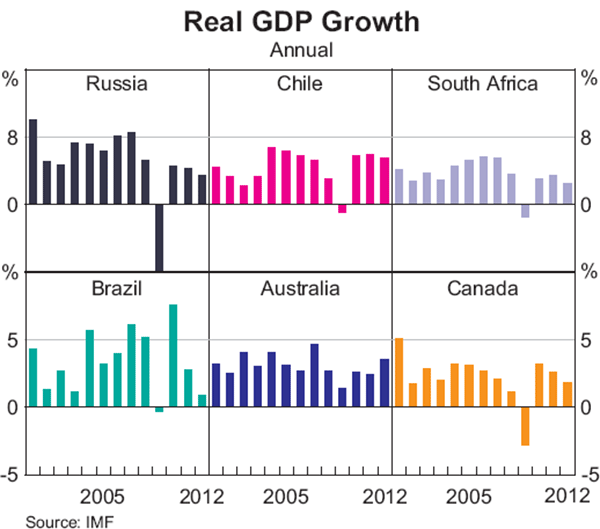
Macroeconomic stabilisation policy
The resources boom posed significant challenges for policymakers, including the potential for the surge in resource-related activity to generate inflationary pressures, and structural change resulting from the appreciation of the real exchange rate. To maintain macroeconomic stability, most of the resource-exporting economies relied on the combination of an inflation targeting framework for monetary policy with a flexible exchange rate, and fiscal policy with the aim of balancing the budget over the medium term. Many resource-exporting economies also had explicit fiscal rules or set up sovereign wealth funds to address some of these challenges (Kearns and Lowe 2011; Garton 2012; Garton and Gruen 2012). Governments in Australia, Russia, Chile and Canada generated relatively large budget surpluses through the mid 2000s until the global financial crisis (Graph 17). In addition, monetary policy was tightened in many economies during this period. However, as commodity prices have begun to ease from their recent peaks, growth in government revenue has slowed, contributing to a downward shift in the budget balance in the resource-exporting economies (apart from Brazil for which the budget position has remained little changed over recent years).
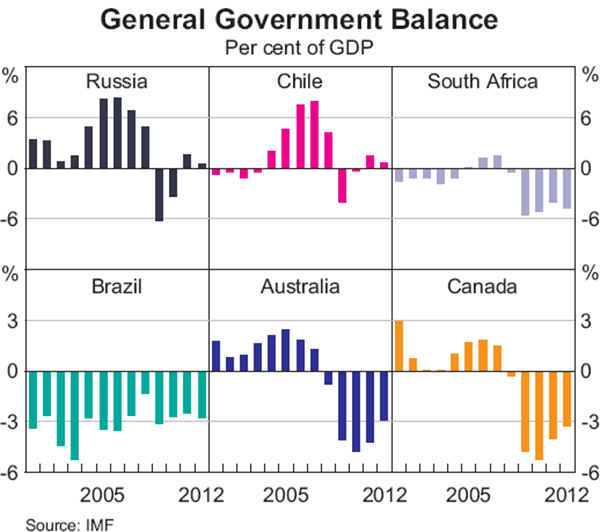
Notwithstanding the magnitude of the resources boom, macroeconomic outcomes have been relatively benign across most of the resource-exporting economies. In Australia, Canada and Chile, inflation was relatively well contained over the past 10 years, especially when compared with the periods of high and volatile inflation experienced during the previous resources boom in the 1970s (Table 4). In addition, output growth was moderate to strong and unemployment typically declined over the decade as a whole, notwithstanding the disruption to growth from the global financial crisis. Such outcomes perhaps partly reflected the benefits of having better anchored inflation expectations, assisted in many of the resource-exporting economies by an inflation-targeting monetary policy framework, a flexible exchange rate and a balanced budget over the medium term. For Australia, the floating exchange rate has been an important part of the economic adjustment by allowing the real exchange rate to rise through an appreciation of the nominal exchange rate rather than through higher inflation.[6]
| Australia | Brazil | Canada | Chile | Russia(a) | South Africa | |
|---|---|---|---|---|---|---|
| Average inflation | ||||||
| 1971–1980 | 10.5 | 38.1 | 8.6 | 131.0 | na | 11.2 |
| 2003–2012 | 2.8 | 6.0 | 1.8 | 3.0 | 10.0 | 5.2 |
| Inflation volatility(b),(c) | ||||||
| 1971–1980 | 5.3 | na | 3.0 | 463.5 | na | 4.4 |
| 2003–2012 | 1.8 | 3.8 | 2.5 | 3.5 | 3.7 | 3.1 |
| Average output growth | ||||||
| 1971–1980 | 3.0 | 8.1 | 4.1 | 2.5 | 2.4 | 3.3 |
| 2003–2012 | 3.0 | 3.5 | 1.8 | 4.8 | 4.6 | 3.4 |
| Output growth volatility(b) | ||||||
| 1971–1980 | 5.8 | na | 3.9 | na | na | 4.6 |
| 2003–2012 | 2.0 | 5.0 | 2.7 | 5.3 | 7.2 | 2.7 |
|
(a) Data for 1971–1980 are for the USSR Sources: ABS; Baer (1987); RBA; Thomson Reuters; The Conference Board, Total Economy DatabaseTM |
||||||
Conclusion
The resource-exporting economies all experienced substantial resources booms over the past 10 years, associated with the surge in demand from emerging Asia and the rise in global commodity prices. Australia experienced a particularly large boost to demand and investment owing to the composition of its resource endowment. Overall, the economic outcomes for the resource-exporting economies were generally positive, supported by macroeconomic stabilisation frameworks.
Footnotes
The authors are from Economic Analysis Department. [*]
Shell's Prelude project, currently under construction, is the world's first floating LNG project, and when complete will be moored off the north-west coast of Australia. Woodside is considering using Shell's floating LNG technology to develop the Browse gas basin, also located off the north-west coast of Australia. [1]
In this article, the output of the resources sector is measured as the gross value added from mining; the other traded sector is measured as the gross value added from the manufacturing and agriculture, forestry & fishing industries, while the non-traded sector is measured as the value added from all remaining industries including services, utilities and construction. For a more detailed three-sector analysis for Australia, see Plumb, Kent and Bishop (2013). [2]
Other factors have also affected the real exchange rate in these economies over this period, including episodes of global financial market stress and unconventional monetary policies in many advanced economies. [3]
The decline in the share of the traded sector is also affected by relative price movements; while strong demand pushed resource prices up, prices in the other trade-exposed sector, and manufacturing in particular, have tended to increase less rapidly than the overall price level, partly owing to ongoing productivity improvements. These relative price changes contributed to decreases in the share of nominal GDP accounted for by the other trade-exposed sector. [4]
Although positive spillover effects from the higher terms of trade have contributed to the increasing share of the non-traded sector of the economy, it is worth bearing in mind that the shift in demand away from agriculture and manufacturing towards services has been going on for a much longer time. This same broad trend is apparent in other advanced economies, not just in the Australian and commodity-exporting economies (Connolly and Lewis 2010; Lowe 2012). [5]
Jääskelä and Smith (2013) show that in Australia the flexible exchange rate has reduced economic volatility by absorbing external shocks, including changes in commodity prices; see also Battellino (2010). [6]
References
Alquist R and J-D Guénette (2013), ‘A Blessing in Disguise: The Implications of High Global Oil Prices for the North American Market’, Bank of Canada Working Paper 2013-23.
Angevine G, M Cervantes and V Oviedo (2012), Fraser Institute Global Petroleum Survey 2012, Fraser Institute, Vancouver.
Baer W (1987), ‘The Resurgence of Inflation in Brazil, 1974–86’, World Development, 15(8), pp 1007–1034.
Battellino R (2010), ‘Mining Booms and the Australian Economy’, RBA Bulletin, March, pp 63–69.
BP (2013), ‘Statistical Review of World Energy 2013’. Available at <http://www.bp.com/content/dam/bp/pdf/statistical-review/statistical_review_of_world_energy_2013.pdf>.
Coates B and N Luu (2012), ‘China's Emergence in Global Commodity Markets’, Australian Treasury Economic Roundup, Issue 1, pp 1–30.
Connolly E and C Lewis (2010), ‘Structural Change in the Australian Economy’, RBA Bulletin, September, pp 1–9.
Connolly E and D Orsmond (2011), ‘The Mining Industry: From Bust to Boom’, RBA Research Discussion Paper No 2011-08.
Ericsson M (2003), ‘Project Investment Survey 2003’, Engineering and Mining Journal, January, pp 28–34.
Ericsson M and V Larsson (2013), ‘E&MJ's Annual Survey of Global Mining Investment’, Engineering and Mining Journal, January, pp 28–33.
Francis M (2008), ‘Adjusting to the Commodity-Price Boom: The Experience of Four Industrialized Countries’, Bank of Canada Review, Autumn, pp 29–41.
Garton P (2012), ‘Sovereign Wealth Funds and The Exchange Rate: Comparing Resource Booms in Australia, Chile and Norway’, Australian Treasury Economic Roundup, Issue 2, pp 19–38.
Garton P and D Gruen (2012), ‘The Role of Sovereign Wealth Funds in Managing Resource Booms: A Comparison of Australia and Norway’, Address to the Third Annual Asia Central Bank and Sovereign Wealth Fund Conference, 23 February.
IEA (International Energy Agency) (2011), Coal Medium-Term Market Report 2011, OECD/IEA, Paris.
IEA (2013), Gas Medium-Term Market Report 2013, OECD/IEA, Paris.
Jääskelä J and P Smith (2013), ‘Terms of Trade Shocks: What Are They and What Do They Do?’, Economic Record, 89, pp 145–159.
Jacobs D (2011), ‘The Global Market for Liquefied Natural Gas’, RBA Bulletin, September, pp 17–27.
Kearns J (2013), ‘Lessons from the Financial Crisis: An Australian Perspective’, in J Braude, Z Eckstein, S Fischer and K Flug (eds), The Great Recession: Lessons for Central Bankers, MIT Press, Cambridge, pp 245–268.
Kearns J and P Lowe (2011), ‘Australia's Prosperous 2000s: Housing and the Mining Boom’, RBA Research Discussion Paper 2011-07.
Lowe P (2012), ‘The Changing Structure of the Australian Economy and Monetary Policy’, Address to the Australian Industry Group 12th Annual Economic Forum, Sydney, 7 March.
Plumb M, C Kent and J Bishop (2013), ‘Implications for the Australian Economy of Strong Growth in Asia’, RBA Research Discussion Paper No 2013-03.
Roberts I and A Rush (2010), ‘Sources of Chinese Demand for Resource Commodities’, RBA Research Discussion Paper No 2010-08.
Wilson A, F McMahon and M Cervantes (2013), Fraser Institute Annual Survey of Mining Companies 2012/2013, Fraser Institute, Vancouver.